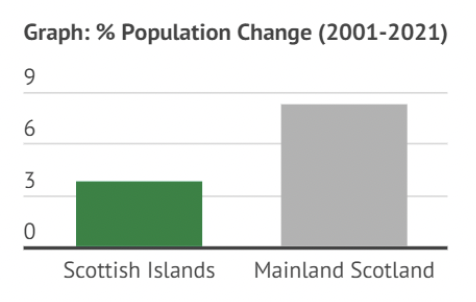Scottish islands: data overview 2023
This report gives a snapshot of Scotland's island-level data as collated in the new Scottish Islands Data Dashboard and draws out key findings relating to each of the strategic objective topic areas set out in the National Islands Plan.
3 Population
Whilst the overall population of Scotland's Islands has grown over the last 20 years,there is considerable variation and some islands have a declining population. Projected loss of working age population in the islands is anticipated to be disproportionately higher than elsewhere.
Population growth has been strongest in Orkney Mainland and Connected Islands and the Highland Islands, which have seen a population growth of 20% and 13% respectively. However, the population in Arran, Bute and the Cumbraes and the Shetland Outer Isles has declined by 13% and 9% respectively.
Large population losses are predicted in Island Sparsely Populated Areas (SPAs). Population sparsity presents direct difficulties for the viability of communities, businesses and services due to low access to people. Furthermore, the percentage loss of working age population in the islands is anticipated to be disproportionately higher than the total percentage loss of population.
The 2022 Census shows that Na h-Eileanan Siar saw the biggest population decrease (down 5.5%), while a 1.2% decrease in the Shetland Islands was driven by out-migration. In contrast, the Orkney Islands have grown by 3%.

The projected population percentage change shows the highest reduction in children and working age population is in islands and remote rural areas (-23% and -15%).
Source: Mid-year population estimates by Scottish Island Region, National Records of Scotland (2021)
Contact
Email: socialresearch@gov.scot
There is a problem
Thanks for your feedback